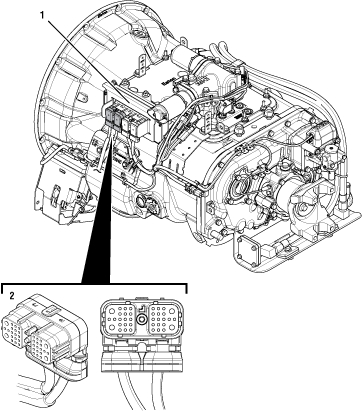Fault Code 74: Engine Speed / Torque Response
J1587: MID 130 PID 93 FMI 7
J1587: MID 130 PID 190 FMI 7
J1939: SA 3 SPN 518 FMI 7
J1939: SA 3 SPN 898 FMI 7
Overview
The UltraShift PLUS transmission Transmission Electronic Control Unit (TECU) communicates with the engine ECU over the J1939 Data Link. During every shift, the TECU receives speed and torque information from the engine and requests changes in speed or torque from the engine to synchronize shifts. If the engine does not respond to speed or torque commands and no J1939 communication fault codes are present, the fault is set.
Detection
TECU monitors the net torque output and calculates the synchronization speed required to shift efficiently. If a request is sent to increase or decrease engine torque or speed and the engine does not respond or does not respond fully, the fault is set. Fault Code 74 sets Active when one of these conditions exists.
Conditions to Set Fault Code Active
FMI 7 – Mechanical System Not Responding: TECU detects no speed or torque response from the engine for more than 2 consecutive seconds after the request is sent.
Fallback
FMI 7
- “F” flashes in gear display.
- Service light flashes (if equipped).
- Transmission may not attempt a shift.
- Transmission may engage a start or reverse gear from neutral, but will not shift out of that gear.
Conditions to Set Fault Code Inactive
FMI 7: Four seconds after the engine responds to TECU speed or torque request.
Possible Causes
FMI 7
- Engine
- Incorrect engine software settings
- Low engine power or mechanical engine issues
- Engine ECU
Component Identification
 |
1. Transmission Electronic Control Unit (TECU) 2. 38-Way Vehicle Harness Connector |
Fault Code 74 Troubleshooting
Record the transmission fault codes, FMIs, occurrences, and timestamps from the Service Activity Report created during the Diagnostic Procedure.
Notice
If an engine software update was recently performed and Fault Code 74 is Inactive, Go to Step D
If Fault Code 74 is Active or Inactive, Go to Step B
Set parking brake and chock wheels.
Verify that engine software is at latest level.
Ensure that the engine configuration settings are correct for the transmission installed in the vehicle.
If all settings are correct, Go to Step C
If settings are incorrect, refer to OEM guidelines for proper engine configurations and software settings. Go to Step V
Note: Reference engine configuration settings in the Eaton Automated Transmission Engine Configuration Settings Guide, TRIG0910, for settings as defined by Eaton for UltraShift PLUS transmissions.
Key off.
Inspect engine and engine systems for any issue causing low or reduced engine power (e.g., leaking fuel injectors, boost leaks, cooling problems, etc.)
If no engine issues are present, refer to OEM guidelines for diagnostic procedure for engine power. Go to Step V
If engine issues are present, refer to engine manufacturer for engine repair diagnostics. Go to Step V
Set parking brake and chock wheels.
NoticeKey on with engine off.
Connect ServiceRanger.
Record the transmission fault codes, FMIs, occurrences, and timestamps.
If Fault Code 74 is Inactive, test complete. Go to Step V
If Fault Code 74 is Active, Go to Step D
Key off.
Reconnect all connectors and verify that all components are properly installed.
Key on with engine off.
Clear fault codes using ServiceRanger.
Drive vehicle and attempt to reset the code or duplicate the previous complaint.
Check for fault codes using ServiceRanger.
If no fault codes set and vehicle operates properly, test complete.
If Fault Code 74 sets Active during the test drive, Go to Step A
If a fault code other than 74 sets Active, troubleshoot per Fault Code Isolation Procedure Index.